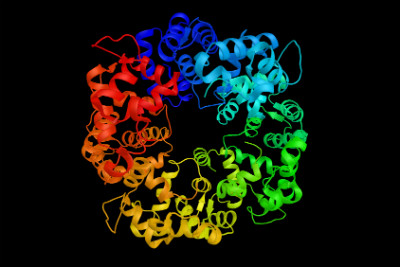Latest research on protein folding poses serious questions for an evolutionary origin
The journal Nature recently published a detailed and fascinating review about the way proteins in our bodies are helped by other proteins, known as chaperones, to become functional.[1]
Proteins are the most complex molecules in our bodies and are involved in virtually all biological processes. Our cells typically manufacture over 10,000 different proteins, synthesised on ribosomes as chains of up to several thousand amino acids.
 For a protein to function it must fold in to its ‘native state’ which is a complex three-dimensional structure. If a protein fails to fold into its functional structure then it is not only without function but in many cases is actually toxic to the cell. It is thought that, with age, protein folding mechanisms are impaired, which is one of the reasons for the symptoms of ageing and some diseases.
For a protein to function it must fold in to its ‘native state’ which is a complex three-dimensional structure. If a protein fails to fold into its functional structure then it is not only without function but in many cases is actually toxic to the cell. It is thought that, with age, protein folding mechanisms are impaired, which is one of the reasons for the symptoms of ageing and some diseases.
The number of possible shapes that a protein can fold into is very high and folding reactions are very complex, involving the co-operation of many weak, non-covalent interactions. A high percentage of proteins do not fold automatically into the required shape and are at risk of aberrant folding and aggregation. As the abstract to this paper states: “To avoid these dangers, cells invest in a complex network of molecular chaperones, which are ingenious mechanisms to prevent aggregation and promote efficient folding.”
Not only do proteins require other proteins (chaperones) to fold properly, they also require chaperones constantly, after correct folding, to maintain their functional states. This is known as proteostasis.
There is also another whole system in the cell (involving more proteins) called the ‘ubiquitin-proteasome system’ which breaks down irreversibly misfolded and aggregated proteins for safe excretion.
There are a number of different classes of chaperones and one of these, the ‘HSP70’ system, is described in some detail in this review. Chaperones are described as multi-component molecular machines that promote folding through ATP and cofactor-regulated binding and release cycles. HSP70 itself is a large and complex protein which interacts with partially folded proteins to promote precise and correct folding. It requires, at the same time, the assistance of other proteins such as HSP40 and ‘nucleotide-exchange factors’ (NEFs).
This is not the whole story either. Proteins that are still not properly folded are transported ‘downstream’ to another system of proteins; the chaperonins. These are large double-ring complexes that enclose one protein at a time in a sort of cage structure. Within this structure the protein folding is completed before the protein is released.
Those with biological training will want to read more detail in the review; in particular the signalling pathways involved and the way genes are turned on to produce the chaperonins when required.
How does all this fit with current evolutionary theory? One might think that such complex systems are confined to mammals or at least the higher orders of animals. This would be a mistake however, because chaperones and chaperonins are found in bacteria and archaea also. Indeed it would seem that for any cell to function there needs to be not just proteins but, at the same time, these chaperone systems, which are absolutely essential for proper folding and maintenance of proteins. Without such systems, in place already, the cell will not function.
Now, as explained, these chaperone systems are themselves made of proteins which also require the assistance of chaperones to correctly fold and to maintain integrity once folded. Chaperones for chaperones in fact. The very simplest of cells that we know of have these systems in place.
Darwinian evolution requires step by step changes in molecular systems, with one step leading to another in a manner that is statistically reasonable to expect from selection of mutant strains. There is no Darwinian explanation however for the evolution of proteins which already have chaperone systems in place to ensure proper function.
And so this begs the question: where do such ‘ingenious’ systems come from if evolutionary mechanisms fail to provide an answer?
References
[1] Hartl, F.U., Bracher, A,. Hayer-Hartl, M. Molecular chaperones in protein folding and proteostasis. Nature Vol 475. No. 7356. 324-331. (21July 2011).
Image credit:
Thumbnail and article - Ibreakstock, Fotolia images
Antony Latham, 28/12/2016